Mad Hedge Biotech and Healthcare Letter
April 18, 2024
Fiat Lux
Featured Trade:
(A RARE OPPORTUNITY OR A PROBLEMATIC DEBT-ACLE?)
(AMGN), (LLY), (NVO)
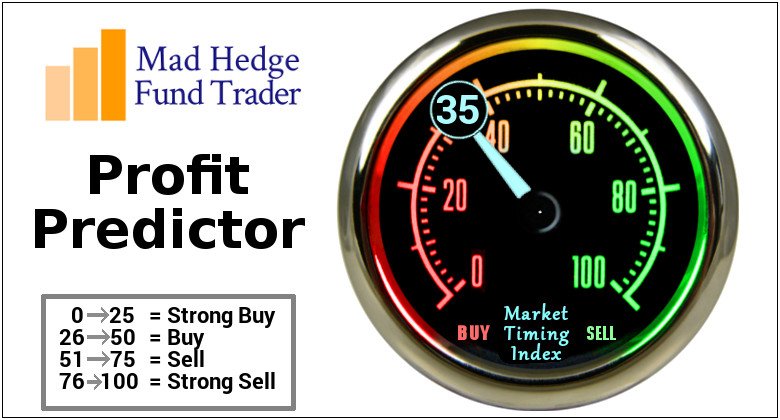
Mad Hedge Biotech and Healthcare Letter
April 18, 2024
Fiat Lux
Featured Trade:
(A RARE OPPORTUNITY OR A PROBLEMATIC DEBT-ACLE?)
(AMGN), (LLY), (NVO)

Remember Gordon Binder and his "Science Lessons?" Well, Amgen (AMGN) seems to be re-reading a few chapters from the book by its legendary former CEO.
Their nearly $28 billion buyout of Horizon Therapeutics (HZNP) screams blockbuster ambition, but it also means they loaded up on debt like it's going out of style. This HAD better work.
Why the gamble? Horizon brings heavyweight rare disease drugs like Tepezza to the table. Sales have been flatlining near $2 billion, but Amgen smells potential. With the indication just expanded and a measly few percent of patients treated, there's room to run...if they can find those patients. That's the tricky part with rare diseases.
Other gems like Uplizna round out the deal. Now, it's all about whether Amgen can make this expensive new portfolio pay.
Let’s take a look at Amgen’s 2024 pipeline. The biotech’s goals this year center on a few key drugs – some acquired, some homegrown.
Tepezza and Uplizna are all about finding those elusive rare disease patients and expanding market access. We're not just talking sales growth here... it's about proving their ability to dominate this niche.
In their "General Medicine" department, there's Olpasiran in Phase 3. A stellar Phase 2 could mean over a BILLION in sales if it gets the green light. But Phase 3, as we know, is where the tough questions get asked.
Over in Oncology, I’m keeping an eye on Tarlatamab, Lumakras, Blincyto, and Nplate. They're the revenue drivers of the future, with Tarlatamab aiming for billions by the 2030s.
Lumakras was supposed to be a star, but it's a bit slow out of the gate. Then there's Blincyto – already raking in the big bucks with nearly 50% year-on-year growth. This one's HOT.
Nplate's a blockbuster with almost $2 billion in sales, but US government orders make it a tad volatile. Tezspire is another potential star, flirting with the billion-dollar mark.
Bottom line? Amgen is hustling to build a diverse portfolio for the long haul.
Crunching the numbers, Amgen's 2024 guidance looks strong, boosted by that Horizon acquisition.
They're projecting about $33 billion in revenue and decent EPS. Tax breaks and low capital expenditures are sweet bonuses.
But...remember that debt. It's over $60 billion on the long-term books. Luckily, Amgen locked in good rates on those bonds, but that interest bill? It's a beast they'll have to tame eventually.
Amgen’s shareholder returns are mostly a chunky 3%+ dividend, not much to write home about. The real magic depends on those high-powered sales teams turning the rare disease business into a cash machine and seeing those other drugs deliver. If it happens, cash flow will surge, and everyone will get fatter payouts.
As for the biggest threat to Amgen’s future? The ever-changing, cash-hungry beast that is the biotech industry.
Amgen's constantly fighting patent expirations, forcing them to pump cash into R&D just to stay ahead. You hit some home runs, like the crazy new weight loss drugs driving skyrocketing revenues as seen in the success of Eli Lilly (LLY) and Novo Nordisk (NVO), but more often, you strike out. This is why long-term investors in Amgen should strap in for a bumpy ride.
Overall, Amgen's got a unique mix of assets. And that Horizon Therapeutics move? Bold but calculated. It gives them a boatload of rare-disease drugs and pairs them with top-notch sales teams.
Plus, there's a bunch of promising candidates in their pipeline. The biotech world is an industry where success is never guaranteed, BUT Amgen's got the potential to keep knocking it out of the park. If they do, those shareholder returns should get a whole lot sweeter. I suggest you buy the dip.

Mad Hedge Biotech and Healthcare Letter
April 11, 2024
Fiat Lux
Featured Trade:
(BELLY BUSTERS)
(NVO), (LLY), (JNJ), (AMGN), (RHHBY), (GSK), (VKTX)

Did you know that more Americans are now trying to lose weight than trying to quit smoking? That's a staggering shift, and it has a lot to do with the buzz around those new obesity drugs.
Novo Nordisk (NVO) got the ball rolling in 2021 when they received the green light to market their diabetes drug, Ozempic, as a weight loss miracle called Wegovy.
Not to be outdone, Eli Lilly (LLY) swooped in the fall of 2023 with Mounjaro – also a diabetes drug, sold as Zepbound – that got the FDA nod for weight loss, too.
Then, the whole pharma world, it seems, has started to go all-out on obesity, flooding the market with a whole new generation of weight loss drugs.
To date, there are 124 obesity meds in the works – a mix of 61 Phase 1 hopefuls, 47 in Phase 2, eight in Phase 3, and eight already greeting patients.
Remember that whole fen-phen disaster back in the 90s? That left a bad taste in everyone's mouth when it comes to weight loss drugs.
But things are different this time. These new obesity meds, especially those from Novo Nordisk and Lilly, are a game-changer. They're blowing those old weight loss pills out of the water.
It's not about fitting into those skinny jeans anymore (though that's a nice bonus). The focus is on health.
And while Novo Nordisk and Eli Lilly might be the big names in the obesity drug game, they've got competition. There's a whole crew of pharma companies jumping on the bandwagon, like Currax Pharmaceuticals, Roche (RHHBY), GlaxoSmithKline (GSK) – you get the picture.
But here's the really wild part about these drugs like Mounjaro and Wegovy, which use GLP-1 (Glucagon-like peptide-1) compounds to treat diabetes: They kinda stumbled onto their weight loss powers by accident.
Turns out, while they were busy helping diabetes patients, boom, patients started shedding pounds. Talk about a happy side effect.
As expected, this has created excitement in the market. Now, usually in the drug world, it's baby steps forward. A little better here, a bit less nausea there... yawn.
But with eight of these drugs already in the late stages of development (Phase 3), expect even more surprises as potential breakthroughs could bypass traditional drug trial phases for a faster route to market.
Frankly, I'm shocked at the number of new mystery drugs suddenly popping up in early testing. Even those old-school Big Pharma players are jumping in: AstraZeneca (AZN), Novartis (NVS), Amgen (AMGN), and, heck, even Johnson & Johnson (JNJ) – everyone wants a slice of the obesity pie.
Now, this whole obesity meds craze reminds me of what happened with those PD-1 drugs in cancer treatment.
One good result, and suddenly everyone was scrambling to get their version to market. But like in a reality TV show, not everyone makes it to the finale.
But what's the endgame in this obesity market expansion? Not 124 contenders, that's for sure.
Even right now, with everything in its early stages, you can already see which candidates have the potential. The competition's going to get fierce, and only the strongest drugs will survive.
Viking Therapeutics (VKTX), for example, has a dual GLP-1 and GIP agonist showing serious promise. After just 13 weeks, patients lost an average of 14.7% of their weight.
This data, released in February, proves Viking’s not just chasing the big pharma players; they're running right alongside them.
Now, over at Novo and Lilly, the pace hasn’t slowed down one bit either. Wegovy, which is Novo's contender in the ring, just got a nod in March for something a bit bigger than weight loss.
It’s been approved to tackle some serious heavyweights — cardiovascular deaths, heart attacks, and strokes in adults dealing with obesity or who are overweight. It's like getting a one-two punch for health.
As for Eli Lilly? They’ve been making some noise with tirzepatide, especially around metabolic dysfunction-associated steatohepatitis, or MASH for short.
They’ve got results showing that 74% of adults who were either overweight or obese managed to kick MASH to the curb without any increase in liver scarring after sticking with the treatment for 52 weeks.
Sadly, the biggest roadblock isn't the science, it's the money. It’s not just about making these drugs. It’s about getting them into the hands of those who need them most.
The current scene? A bit of a heartbreaker.
Most US insurance companies are drawing the line at covering Wegovy or Zepbound for obesity. This leaves a hefty bill on the table, putting these potentially life-altering treatments out of reach for many.
Think about it – the people who could benefit the most, maybe those on Medicaid or living paycheck to paycheck, are staring at a closed door. And let’s not even get started on Medicare, which, as of now, can’t even touch these drugs.
It’s a strange paradox, isn’t it? The very treatments that could lift the weight of obesity off society’s shoulders are dangling just out of reach for many.
So, now, the burning question isn’t so much about whether these treatments can make shareholders and companies do a happy dance. It’s more about where we’re heading.
Think about cancer treatment – the sickest patients get the cutting-edge drugs first. What would that even look like in obesity?
Will all these 124 experimental options help level the playing field, finally forcing insurers to step up? Only time will tell.
As of now, the obesity treatment field is going through a revolution. While the market faces challenges like accessibility, I suggest you closely monitor the progress of key players like Novo Nordisk and Eli Lilly.
Consider smaller, innovative companies, such as Viking Therapeutics, for potential high-risk, high-reward investments as well.
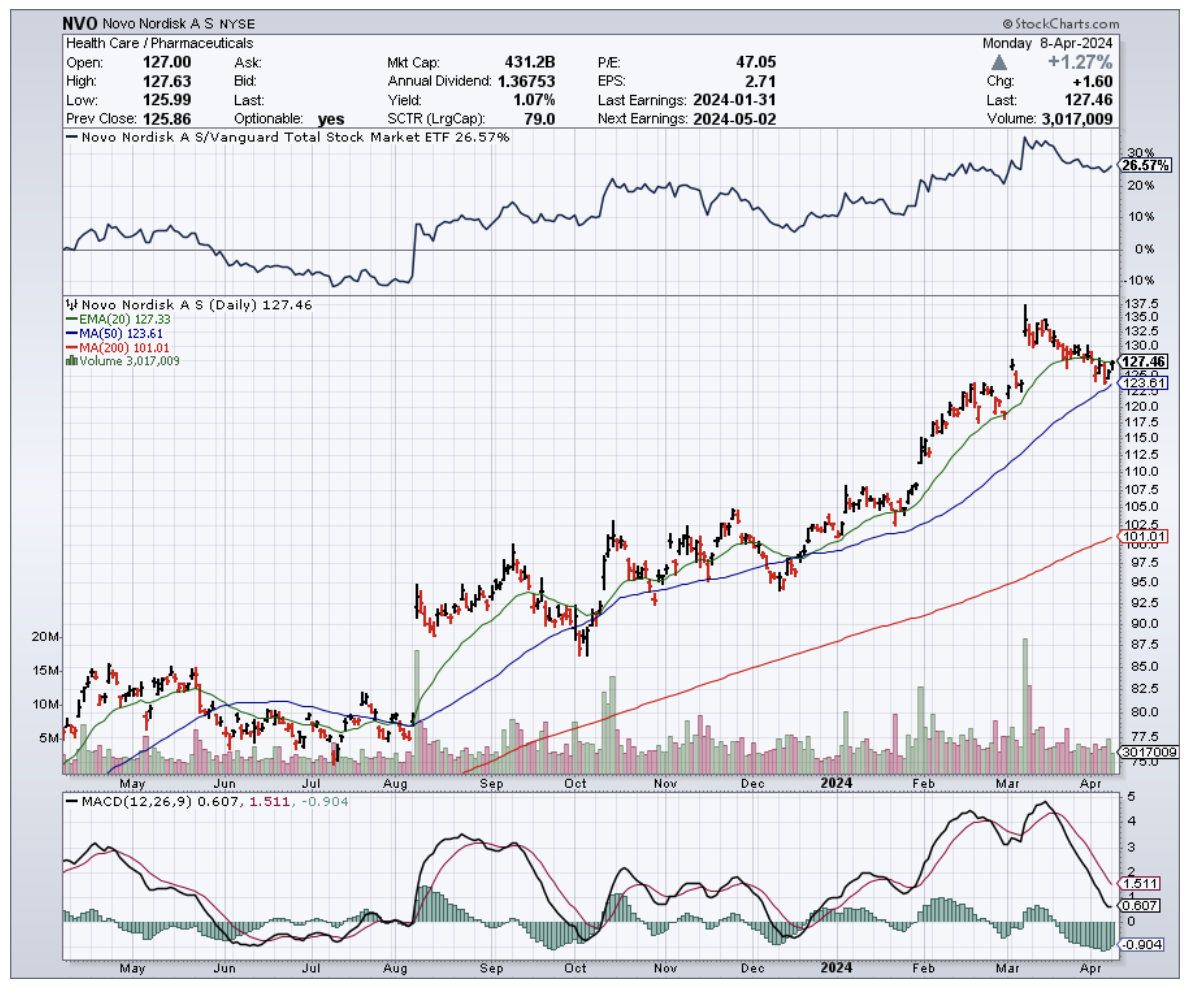
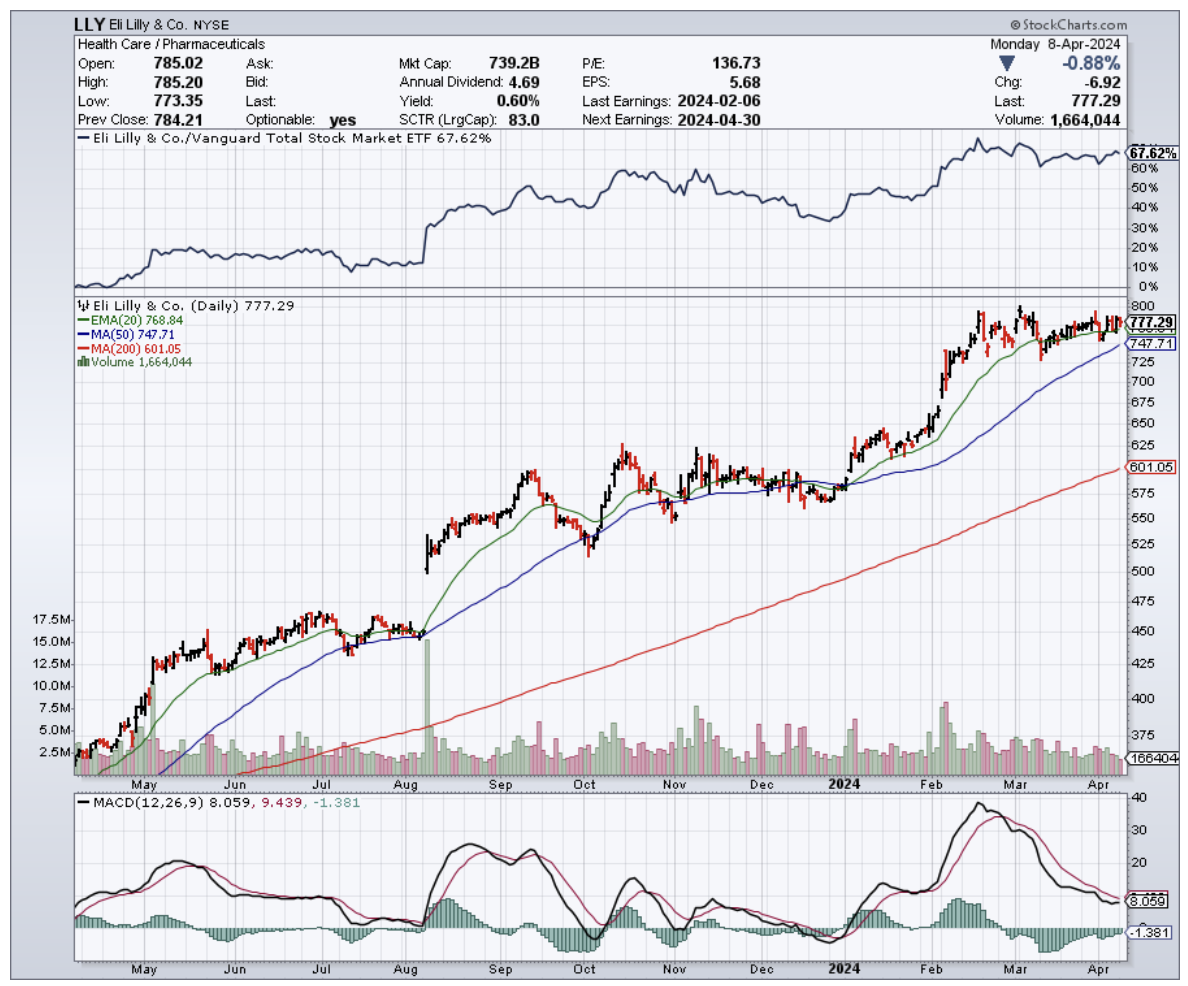
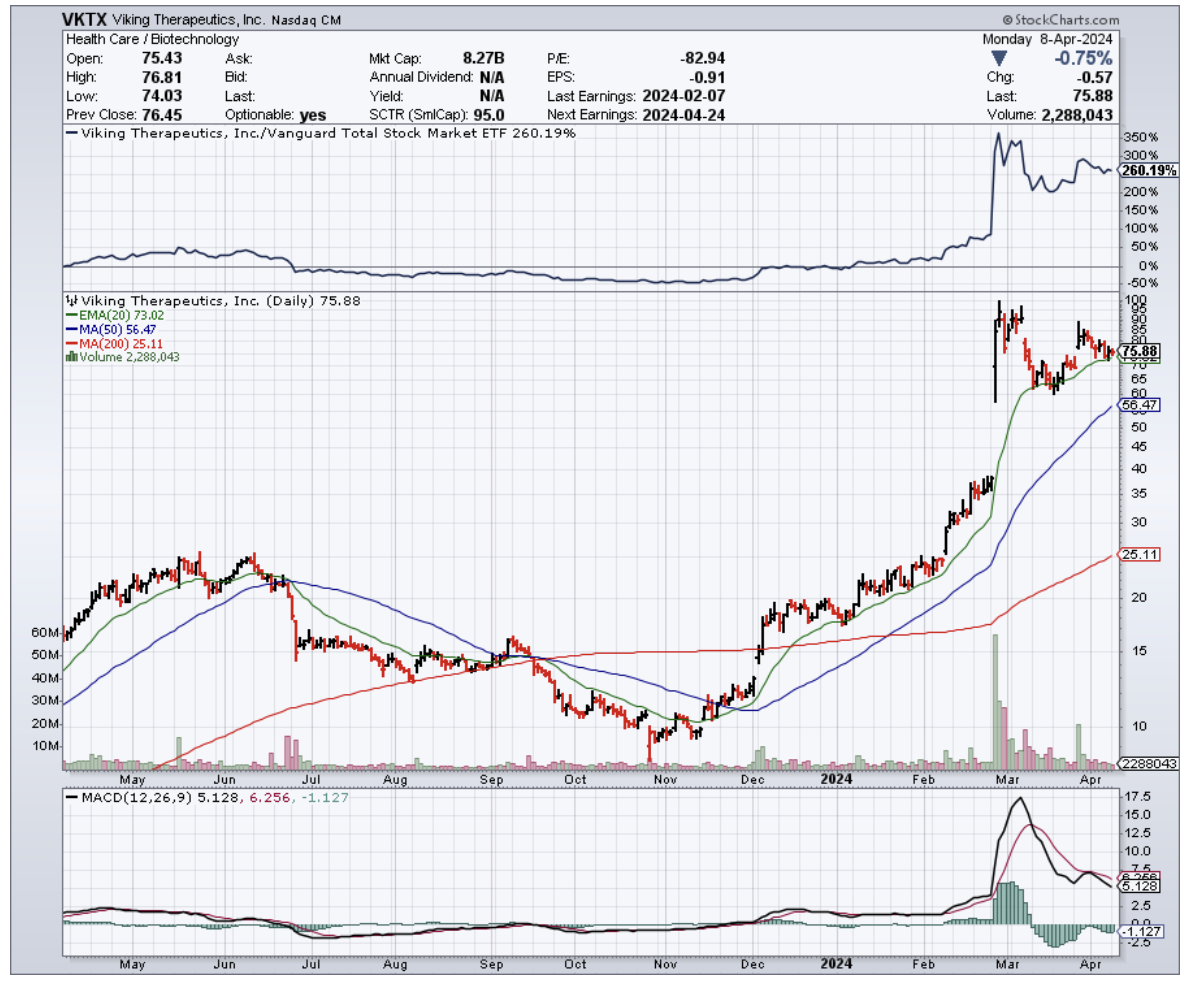
Mad Hedge Biotech and Healthcare Letter
March 21, 2024
Fiat Lux
Featured Trade:
(THE TOP DOG IN ANIMAL HEALTHCARE)
(ZTS), (AMGN), (PFE), (JNJ), (ELAN)
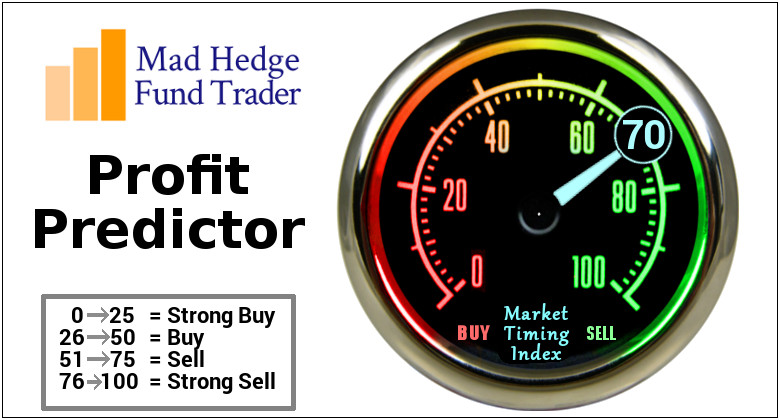
You've likely witnessed a scene like this: You're at the park, and you see a young couple playing fetch with their golden retriever.
The dog is absolutely loving life, jumping and bounding after the ball, tail wagging furiously. It's a heartwarming scene, and it's one that's becoming more and more common these days.
In fact, just the other day, over coffee, a veterinarian buddy of mine spilled the beans.
"You wouldn't believe how people are pampering their pets these days," she said, shaking her head in amusement. "It's no longer just about the basics—food and health. Nope, we're talking top-tier, VIP treatment. They're ready to drop serious cash to ensure their furry friends are living their best lives."
It's a whole new world for pets, and their owners are leading the charge, wallets wide open.
And that is where Zoetis (ZTS) comes in. This company is the top dog (pun intended) in the animal healthcare space, and it's been making some serious waves in the market lately.
Now, I know what you're thinking - "What about those big-shot human healthcare stocks like Amgen (AMGN), Johnson & Johnson (JNJ), and Pfizer (PFE)?"
Well, let me tell you, Zoetis has been giving them a run for their money since spinning off from Pfizer back in 2013. This company has been posting positive annual EPS growth every single year, with an average annual EPS growth rate of a whopping 15.9%.
But that's not all — Zoetis has also been dishing out some seriously impressive dividend growth, with a CAGR of nearly 25% since it was spun off. That's right, this stock is checking all the boxes for dividend growth investors.
And if you think this is just an income play, think again.
Zoetis has been absolutely crushing the S&P 500, posting price returns of 492% compared to the market's measly 176% gains over the last decade.
So, what's the secret behind Zoetis' success?
Well, it all comes down to our furry (and sometimes scaly) friends. You see, people are lonelier than ever these days, and they're turning to pets for that much-needed companionship.
The US Surgeon General even called loneliness an epidemic, sounding the alarm on its dire impacts on health, likening its risks to smoking up to 15 cigarettes a day.
From the gripping claws of loneliness among young adults to the isolation felt by mothers with young children, the pandemic has only deepened this crisis, affecting a staggering 36% of Americans.
More than that, this loneliness trend isn't just about having a buddy to binge-watch Netflix (NFLX) with. It's actually impacting our species' survival. Studies show that sexual activity is on the decline, and technology is distorting the way we interact with each other.
It's a bit of a downer, I know, but here's where Zoetis shines through. As people turn to pets for love and affection, they're also shelling out some serious cash to keep their furry friends healthy and happy.
The American Pet Products Association says that nearly 87 million U.S. households own pets (roughly 66%), and it's not just the younger generations who are getting in on the action. Baby Boomers and Gen Xers are also big-time pet owners.
What does all this pet love mean for the industry? Well, the pet industry is expected to be a $150 billion behemoth in 2024.
Now, what really sets Zoetis apart from the pack? It all comes down to pricing power and growth potential.
In the animal health market, drug prices aren't determined by pesky regulations, government buyers, or PBMs. That means Zoetis can charge premium prices for their trusted, name-brand drugs without having to jump through hoops.
Plus, with less competition in the animal health space, Zoetis' products have longer growth runways and aren't constantly battling generic copycats.
For context, Elanco (ELAN), Zoetis' pure-play competitor, only managed to bring in $4.4 billion in sales.
So, what's the bottom line here?
Zoetis is a best-in-breed play on the booming animal healthcare market, with a safe and growing dividend to boot. As this sell-off continues, Zoetis keeps climbing higher on my personal watch list. I'm ready to back up the truck and load up on shares come April when I put my March dividends to work.
If you're looking for a unique way to play the healthcare space with a company that's got plenty of bark and bite, Zoetis might just be the stock for you.
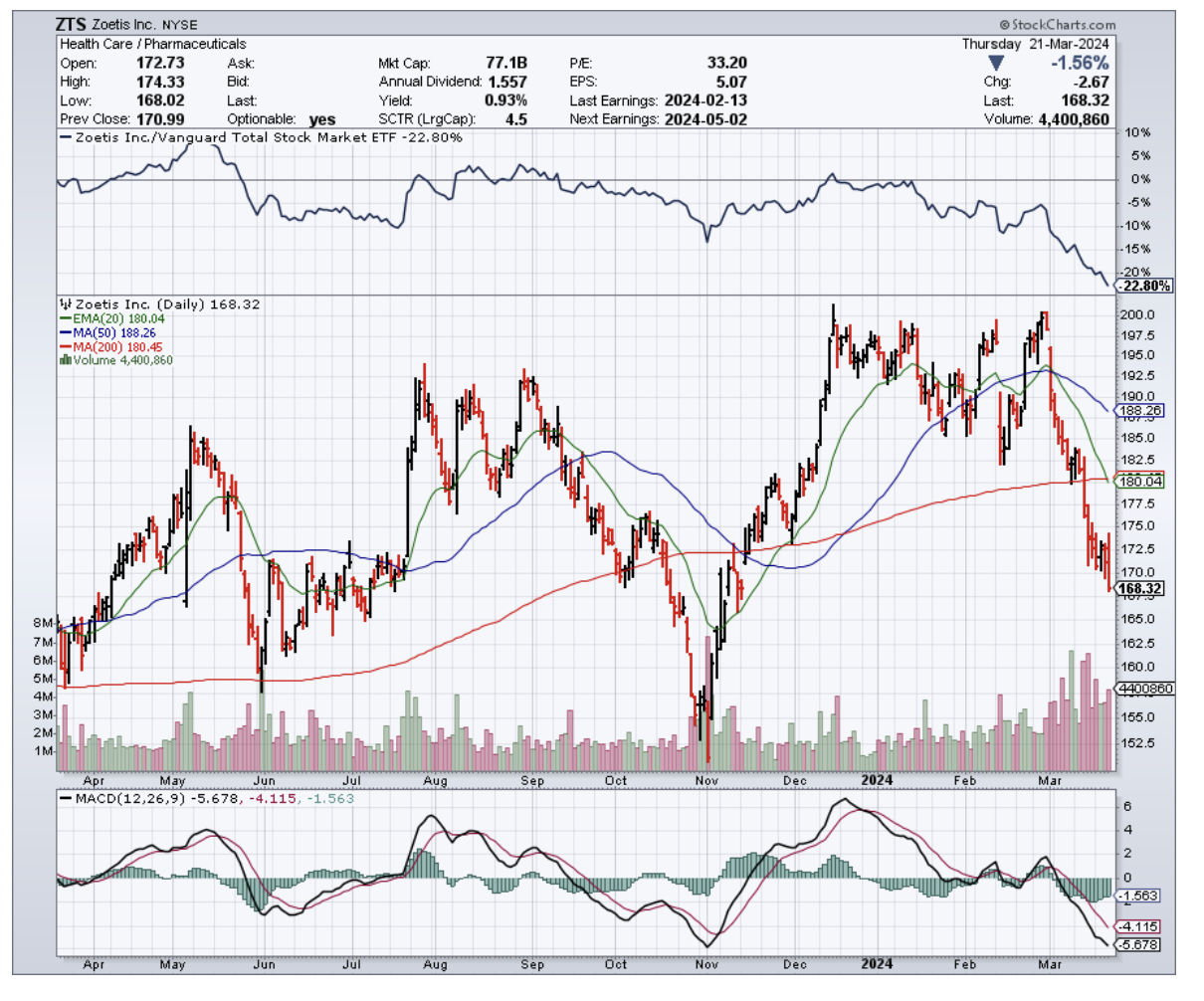
Mad Hedge Biotech and Healthcare Letter
March 19, 2024
Fiat Lux
Featured Trade:
(NOT JUST A ONE-TRICK PONY, BUT A BIOTECH THOROUGHBRED)
(LLY), (NVO), (PFE), (AMGN)
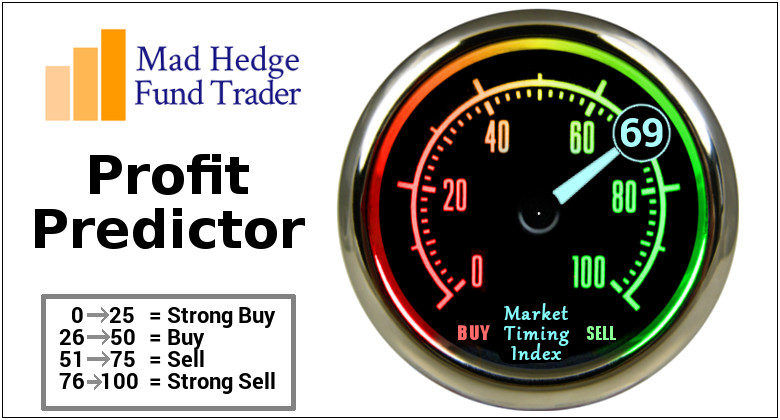
I've been around the block a few times when it comes to investing, and let me tell you, I know a thing or two about spotting a winner. And right now, there's one name in the biotechnology and healthcare world that's caught my eye like a shiny new penny: Eli Lilly (LLY).
First off, let's talk about Lilly's recent partnership with Amazon Pharmacy (AMZN). This pair is bringing the future to us, offering direct home delivery of Lilly's medications, including the much-talked-about weight-loss drug Zepbound.
You heard that right. Thanks to this partnership, you can now get your hands on Lilly's weight-loss wonder drug, Zepbound, without ever leaving your couch.
Approved last year for obesity treatment, Zepbound is shaping up to be a blockbuster. And let's not forget about LillyDirect, the platform making all this possible, blending healthcare provision with top-notch delivery service.
Since launching in 2020, Amazon Pharmacy has been on a mission to simplify how we get our prescriptions, and teaming up with Eli Lilly only turbocharges this mission.
Now, let's talk about Lilly’s financials. This biotech’s market cap has ballooned to an eye-watering $700 billion, thanks to a 130% surge over the past year.
The buzz around Zepbound, showing potential for a 27% reduction in body weight, has investors sitting up and taking notice.
But I hear you ask, "Have I missed the boat on Eli Lilly?" My take? Not at all.
In fact, I think this stock could easily double in value and even surpass the trillion-dollar mark within the next five years. It's a bold prediction, but I've been around long enough to know a sure thing when I see it.
With obesity rates tripling since 1975 and more than half of the global population predicted to become obese or overweight by 2035, the demand for effective treatments like these is going to skyrocket.
Actually, the market for weight loss treatments is projected to reach $100 billion by 2030. And Lilly? They're ready to ride that wave all the way to the bank.
To date, Lilly only has one strong competitor in this space: Novo Nordisk (NVO). While other pharma giants, like Pfizer (PFE) and Amgen (AMGN), are trying their best to gain traction, these two are leaps and bounds ahead.
Now, I know what you might be thinking. "Isn't it expensive to develop these cutting-edge treatments?" You bet your bottom dollar it is.
Lilly isn't afraid to put its money where its mouth is. They're investing heavily in manufacturing capacity to keep up with the inevitable surge in demand. It's a bold move, but that's what separates the winners from the also-rans in the biotech race.
That’s not where it ends though. Lilly has another ace up its sleeve: donanemab, their early Alzheimer's treatment. This could also be a potential competitor of Biogen (BIIB) and Tokyo’s Eisai’s (ESALY) lecanemab, currently marketed as Leqembi.
Sure, the FDA might have put a temporary hold on Lilly’s candidate’s approval, but I've seen this rodeo before. It's just a minor bump in the road for this potentially game-changing drug.
If donanemab gets the green light, it could add billions more to Lilly's already impressive revenue streams. For perspective, the market for Alzheimer’s treatments is predicted to reach $6 billion to $8 billion by 2025 and record $15.5 billion by 2031.
Of course, no investment is without risk. But when I look at Eli Lilly, I see a company that's firing on all cylinders.
They're making strategic partnerships, investing boldly in their future, and have a track record of success that's the envy of the industry.
With a pipeline full of promising treatments, I believe Lilly is poised to gallop its way to even greater heights in the years to come.
So if you're looking for a biotech thoroughbred with a pedigree of success and a bright future ahead, I'd say Lilly is a horse worth betting on.

Mad Hedge Biotech and Healthcare Letter
March 7, 2024
Fiat Lux
Featured Trade:
(RALLY CAPS ON)
(VKTX), (LLY), (NVO), (AKRO), (GILD), (BMY), (AMGN), (PFE)
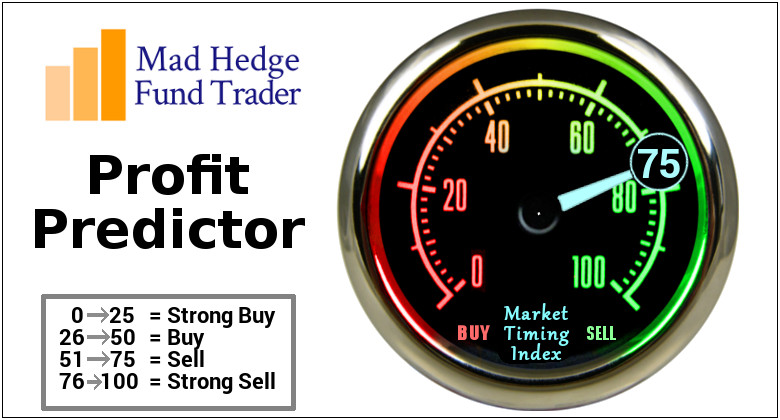
The biotech sector just flipped its rally cap inside out. After a brutal losing streak, it's clawing its way back. The SPDR S&P Biotech (XBI) exchange-traded fund, a barometer for the sector, started to show signs of life when it soared by 5.7% last month, cresting over $100 a share for the first time in two whole years.
While champagne might be premature, this comeback is heating up, and whispers of a full-fledged rally are echoing through Wall Street.
After a rough patch that kicked off in early 2021, seeing the fund take a nosedive of over 60% by late October 2023, the tide began to turn last fall. Initially, whispers of lower interest rates in 2024 sparked interest across small-cap indexes, including our biotech heroes.
Yet, lately, the buzz is all about biotech's own merits — think breakthrough medical trials and the juicy prospect of big pharma playing Pac-Man with smaller but promising biotech firms to beef up their drug pipelines.
And let me tell you, if the current rally's got legs, we might just be witnessing the most thrilling biotech comeback in over half a decade. Especially if the merger and acquisition scene stays hot, we could see biotech stocks climbing even higher.
Take everything that happened in the sector in February as an example. Viking Therapeutics (VKTX) threw down the gauntlet with promising data on its weight loss drug, VK2735, making investors sit up and take notice.
Actually, this candidate is shaping up to be a formidable rival to obesity treatments from Eli Lilly (LLY) and Novo Nordisk (NVO), sending Viking's shares skyward by a jaw-dropping 121% in a single day.
And it's not just Viking stealing the spotlight. Another biotech named Akero Therapeutics (AKRO) also bounced back with some impressive data of its own, challenging the doom and gloom that settled over biotech firms following Eli Lilly's bombshell MASH trial results.
Akero's mid-stage study showed that their drug, efruxifermin, could significantly roll back liver fibrosis in MASH patients — putting a whopping 75% of high-dose recipients on the mend, a stark contrast to the 24% placebo group.
This revelation was a game-changer, especially after Lilly's tirzepatide threw the sector for a loop, hinting at a potential endgame for MASH-specific treatments. But while Lilly's announcement left many details to the imagination, Akero's clear-cut results have reignited excitement over what might be the best MASH treatment yet seen.
As expected, in the midst of this resurgence, the likes of Viking and Akero are catching eyes not just for their groundbreaking treatments but also as tantalizing acquisition targets. Heavyweights like Gilead Sciences (GILD), Bristol Myers Squibb (BMY), Amgen (AMGN), and Pfizer (PFE) are said to be circling, each eyeing a slice of the biotech pie.
As for the biotech investment landscape in general, it's buzzing with renewed vigor. The early months of 2024 have welcomed a smattering of biotech IPOs, a refreshing change after a long drought. CG Oncology's late January debut practically set the market ablaze, doubling in value on its first trading day.
Moreover, public biotechs have found a lifeline in PIPE deals, sidestepping the regulatory hoops of secondary offerings. For instance, Denali Therapeutics' (DNLI) recent PIPE deal, expected to rake in $500 million, is proof of the sector's warming investment climate.
So, dust off those rally caps because the biotech sector isn't just back in the game – it's swinging for the fences.
Breakthrough treatments, a sizzling M&A market, and investors throwing their support behind innovation — this rally has all the ingredients to paint a bright future for the industry. While there will be bumps along the road, one thing's for sure: the biotech sector is poised for a season no one wants to miss.
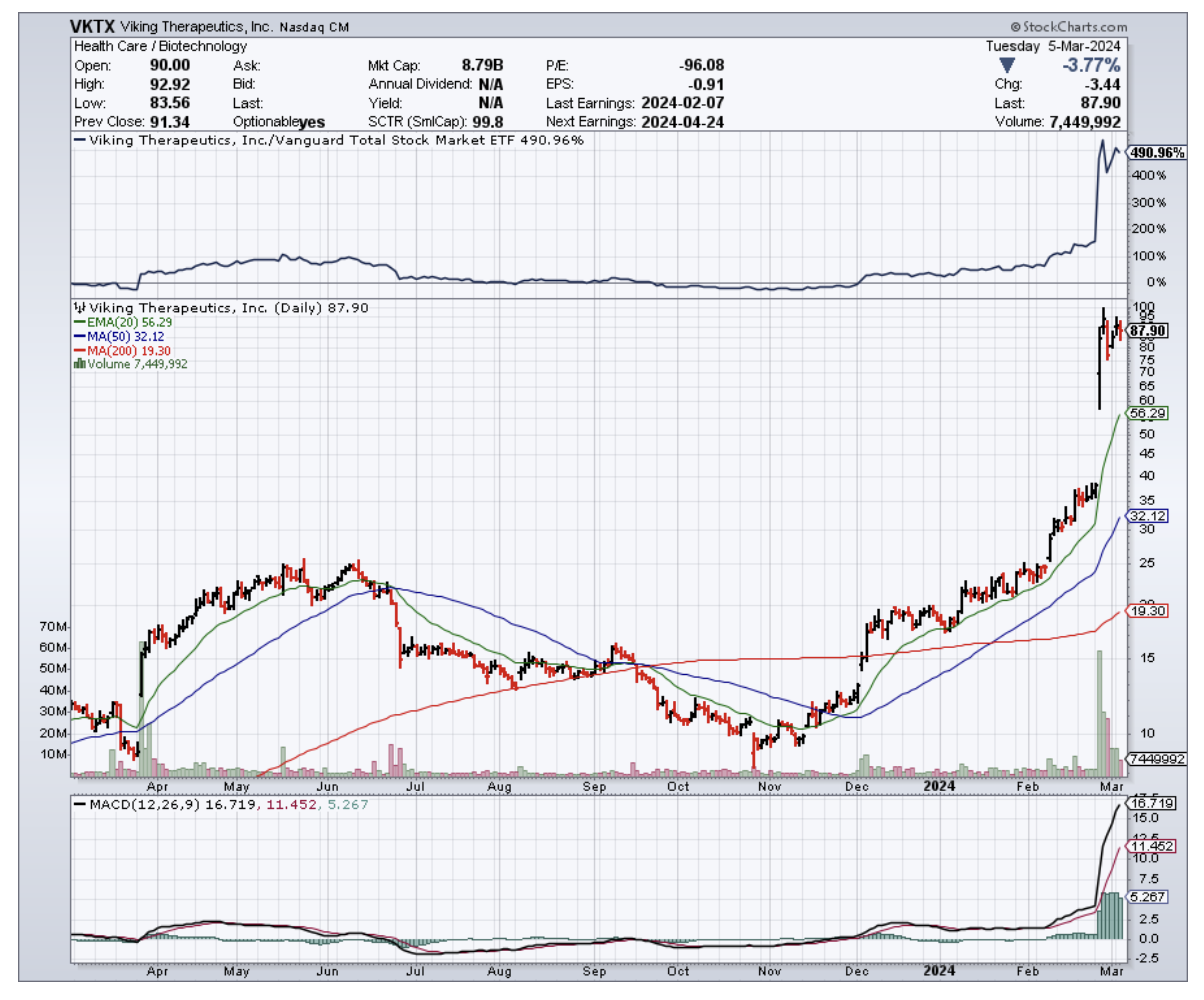
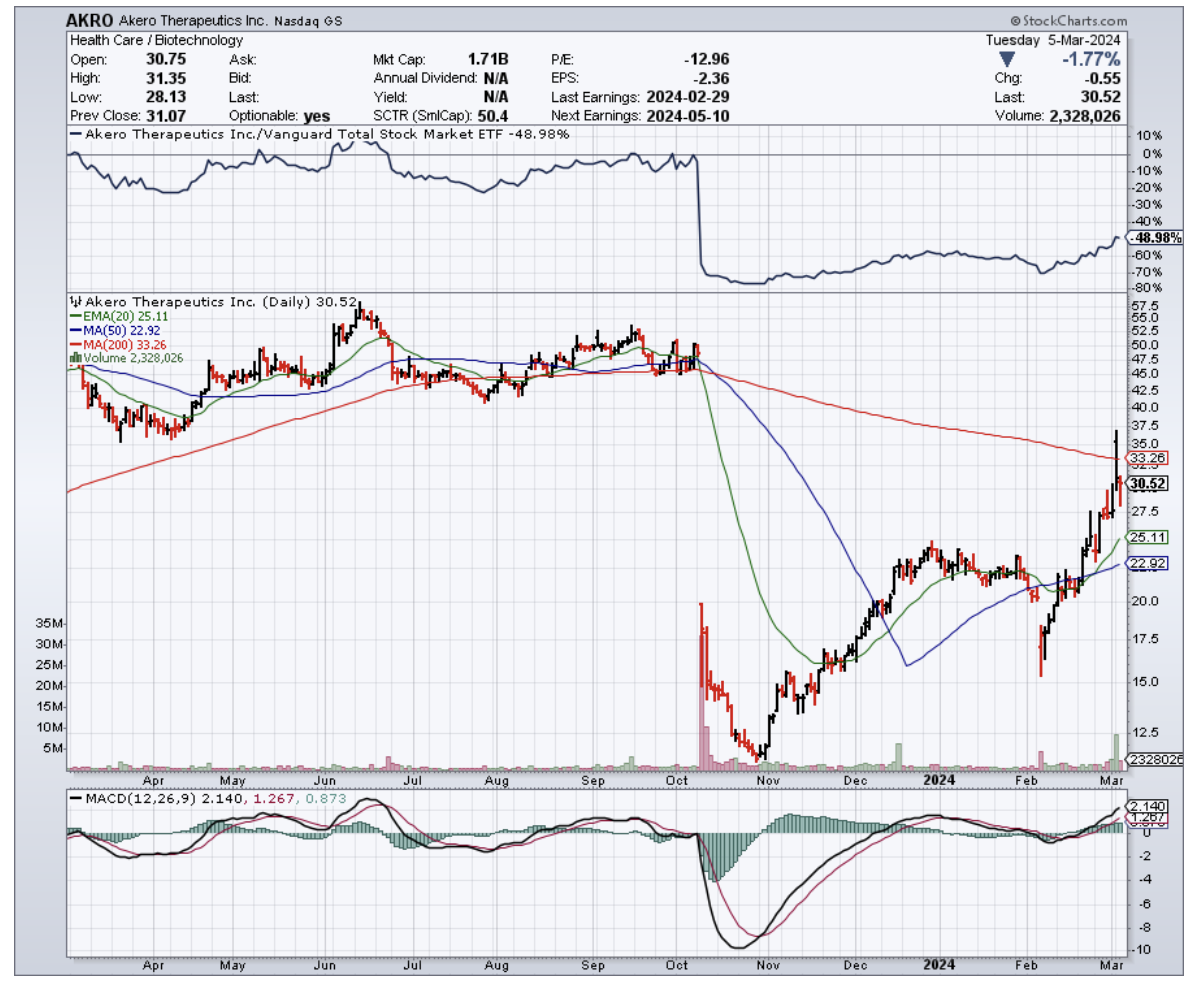
Legal Disclaimer
There is a very high degree of risk involved in trading. Past results are not indicative of future returns. MadHedgeFundTrader.com and all individuals affiliated with this site assume no responsibilities for your trading and investment results. The indicators, strategies, columns, articles and all other features are for educational purposes only and should not be construed as investment advice. Information for futures trading observations are obtained from sources believed to be reliable, but we do not warrant its completeness or accuracy, or warrant any results from the use of the information. Your use of the trading observations is entirely at your own risk and it is your sole responsibility to evaluate the accuracy, completeness and usefulness of the information. You must assess the risk of any trade with your broker and make your own independent decisions regarding any securities mentioned herein. Affiliates of MadHedgeFundTrader.com may have a position or effect transactions in the securities described herein (or options thereon) and/or otherwise employ trading strategies that may be consistent or inconsistent with the provided strategies.
This site uses cookies. By continuing to browse the site, you are agreeing to our use of cookies.
OKLearn moreWe may request cookies to be set on your device. We use cookies to let us know when you visit our websites, how you interact with us, to enrich your user experience, and to customize your relationship with our website.
Click on the different category headings to find out more. You can also change some of your preferences. Note that blocking some types of cookies may impact your experience on our websites and the services we are able to offer.
These cookies are strictly necessary to provide you with services available through our website and to use some of its features.
Because these cookies are strictly necessary to deliver the website, refuseing them will have impact how our site functions. You always can block or delete cookies by changing your browser settings and force blocking all cookies on this website. But this will always prompt you to accept/refuse cookies when revisiting our site.
We fully respect if you want to refuse cookies but to avoid asking you again and again kindly allow us to store a cookie for that. You are free to opt out any time or opt in for other cookies to get a better experience. If you refuse cookies we will remove all set cookies in our domain.
We provide you with a list of stored cookies on your computer in our domain so you can check what we stored. Due to security reasons we are not able to show or modify cookies from other domains. You can check these in your browser security settings.
These cookies collect information that is used either in aggregate form to help us understand how our website is being used or how effective our marketing campaigns are, or to help us customize our website and application for you in order to enhance your experience.
If you do not want that we track your visist to our site you can disable tracking in your browser here:
We also use different external services like Google Webfonts, Google Maps, and external Video providers. Since these providers may collect personal data like your IP address we allow you to block them here. Please be aware that this might heavily reduce the functionality and appearance of our site. Changes will take effect once you reload the page.
Google Webfont Settings:
Google Map Settings:
Vimeo and Youtube video embeds:
